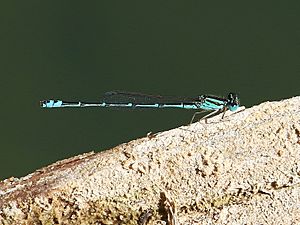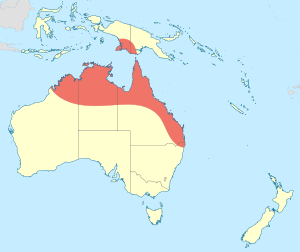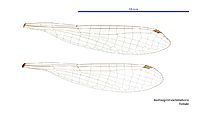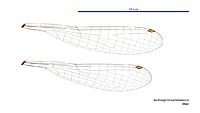Northern billabongfly facts for kids
Quick facts for kids Northern billabongfly |
|
|---|---|
 |
|
| Male, Queensland | |
| Conservation status | |
| Scientific classification | |
 |
The northern billabongfly (scientific name: Austroagrion exclamationis) is a cool insect. It's a type of damselfly, which are like smaller, more delicate versions of dragonflies. This little creature belongs to a family called Coenagrionidae.
Northern billabongflies are quite small. The males are easy to spot because they are bright blue and black. They live in places like New Guinea and northern Australia. You can find them near streams and calm, still water.
Contents
What is a Damselfly?
Damselflies are amazing insects. They are part of a group called Odonata, which also includes dragonflies. While they look similar, damselflies are usually smaller and thinner.
One easy way to tell them apart is by their wings. When a damselfly rests, it usually folds its wings together over its back. Dragonflies, however, often hold their wings out flat to the sides.
Where Do Northern Billabongflies Live?
The northern billabongfly calls a few special places home. You can find them in New Guinea, which is a large island north of Australia. They also live across the northern parts of Australia.
These damselflies love water. They prefer to live near fresh water sources. This includes small streams where the water flows gently. They also like still water, such as ponds or calm parts of rivers. These watery homes are important for their entire life cycle.
What Do Northern Billabongflies Look Like?
The northern billabongfly is a small and pretty insect. The male damselfly has a striking appearance. Its body is a mix of bright blue and black colors. This makes them stand out when they are flying around.
We don't have much information about the female's colors. However, we know they have delicate wings. Both males and females have two pairs of wings. These wings are clear and have a network of tiny veins. These veins help make the wings strong for flying.
The Damselfly Life Cycle
Like many insects, damselflies go through different stages. This is called a life cycle. It starts with an egg and ends with an adult damselfly. This whole process usually happens near water.
From Egg to Adult
The life of a northern billabongfly begins as a tiny egg. The female lays her eggs in or near water. Sometimes, she places them on underwater plants.
Once the egg hatches, a young damselfly emerges. This young form is called a nymph. Damselfly nymphs live underwater. They breathe using special gills. Nymphs are predators, meaning they hunt other small creatures. They eat tiny water insects and even small tadpoles.
As the nymph grows, it sheds its skin many times. This is called molting. Each time it molts, it gets a little bigger. This stage can last for several months or even years.
When the nymph is ready, it crawls out of the water. It finds a plant stem or a rock to cling to. Then, its skin splits open one last time. The adult damselfly slowly pulls itself out of its old skin. This is a truly amazing transformation!
The newly emerged adult damselfly has soft wings. It needs time for its wings to harden. Once they are strong, the damselfly can fly. Adult damselflies live for only a few weeks or months. During this time, they fly, hunt, and find a mate. Then, the females lay eggs, and the cycle begins again.
What Do Damselflies Eat?
Both young and adult damselflies are hunters. They are carnivores, which means they eat meat.
As nymphs living underwater, they are fierce predators. They have a special lower lip that can shoot out. This lip grabs small insects and other tiny water creatures. They are important parts of the underwater food chain.
Adult damselflies fly around and catch insects in the air. They are very good at catching their prey while flying. They mainly eat small flying insects. This includes mosquitoes and gnats. So, damselflies are actually helpful to humans!
Gallery




